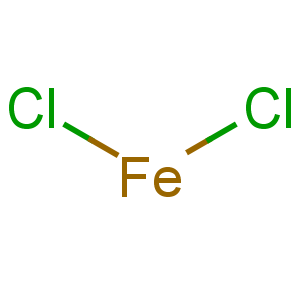Title: Ferrous Chloride
CAS Registry Number: 7758-94-3
Molecular Formula: Cl2Fe
Molecular Weight: 126.75
Percent Composition: Cl 55.94%, Fe 44.06%
Line Formula: FeCl2
Literature References: Occurs in nature as the mineral
lawrencite. Preparation: Kovacic, Brace,
Inorg. Synth. 6, 172 (1960); Kühnl, Ernst,
Z. Anorg. Allg. Chem. 317, 84 (1962). Prepn of dihydrate: Gayer, Woontner,
Inorg. Synth. 5, 179 (1957).
Properties: White rhombohedral crystals; may sometimes have a green tint. Very hygroscopic. mp 674°; bp 1023°; d25 3.16. Can be sublimed in a stream of HCl at about 700°. Forms FeCl3 and Fe2O3 on heating in air. Freely sol in water, alc, acetone; slightly sol in benzene; practically insol in ether.
Melting point: mp 674°
Boiling point: bp 1023°
Density: d25 3.16
Derivative Type: Dihydrate
Properties: White monoclinic crystals with pale green tint. Loses 1 H2O at 120°: Gayer, Woontner,
loc. cit.; also reported to lose 1 H2O at 150-160°: Schafer,
Z. Anorg. Allg. Chem. 258, 69 (1949). Sol in water.
Derivative Type: Tetrahydrate
Properties: Pale green to blue-green, monoclinic crystals or cryst powder. Loses 2H2O at about 105-115°: Schafer,
loc. cit. d 1.93. Sol in water, alcohol. The technical product may not be completely sol without the addn of acid. Aq solns are readily oxidized.
Density: d 1.93
CAUTION: Potential symptoms of overexposure are irritation of eyes, skin, mucous membranes; abdominal pain, diarrhea, vomiting; possible liver damage.
See NIOSH Pocket Guide to Chemical Hazards (DHHS/NIOSH 97-140, 1997) p 174.
Use: In metallurgy; as reducing agent; in pharmaceutical prepns; as mordant in dyeing.

